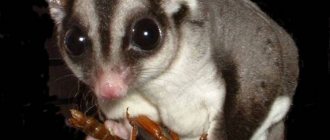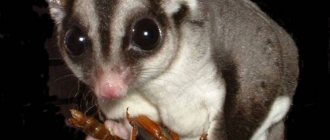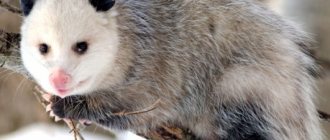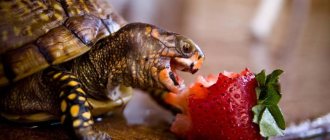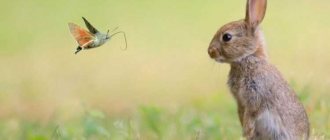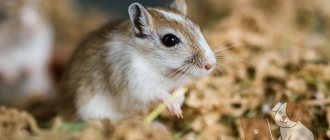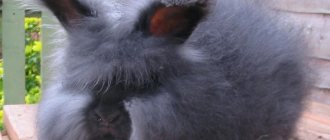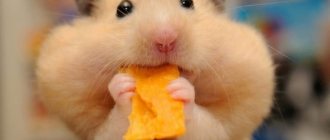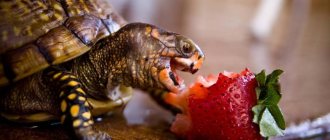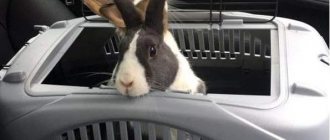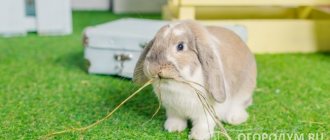The flying sugar glider (from the Latin petaurus breviceps) is a small inhabitant of eucalyptus forests that resembles a squirrel in appearance. The animal belongs to the genus of marsupial flying squirrels of the same family, in the scientific classification it is recorded as a sugar marsupial flying squirrel.
A few more names of the mammal are short-headed flying squirrel, dwarf flying squirrel, Australian flying squirrel. In the wild, the animal is distributed in Australia, New Guinea and the surrounding islands. It received the epithet “sugar” in its name due to its addiction to sweet foods: flower nectar and pollen, sweet juice of trees and fruits.
Sugar squirrel dimensions:
|
Characteristics of the sugar glider
How long do Australian flying squirrels live? | In the wild, usually no more than 5–8 years. This is due to a lot of dangers that await the animal literally at every step. At home, life expectancy is up to 12–15 years. |
Does the sugar glider bite and how to stop it from doing so? | The animal is absolutely not aggressive, so if it does bite, the reasons may be as follows:
|
Can sugar squirrels be trained? | The marsupial flying squirrel is not a stupid creature and responds well to voice intonation. It is quite possible to teach the animal some simple commands, as well as teach it to respond to its nickname. |
Why does a possum often bark at night? | This is usually how the squirrel calls its owner. Most likely, your pet is bored and lonely. Especially if he is alone in a cage. Moreover, around 10 o’clock in the evening the animal only becomes more active, and you, most likely, are already going to bed. If possible, pet the animal, talk to it, and let it out of captivity for a walk around the house. The best option is to purchase a companion and equip the cage in such a way that the residents have something to do. |
Sugar glider price | On the territory of the Russian Federation it varies from 3 to 15 thousand rubles per individual. |
Do I need to vaccinate and deworm my pet? | These animals are not given any vaccinations, including against rabies. There is also no need for antihelminthic drugs. |
Is it necessary to let the animal out of its cage for a walk? | Yes, the flying squirrel is a social creature, it needs communication and walks. Locked within four walls, he can become lethargic or aggressive, and become depressed. |
Distinctive features of flying flying squirrels:
- The animal has a small and slender body, which, due to the presence of flight membranes, seems quite wide.
- The flight membranes extend from the toes of the front toes of the hind feet. At rest, they look like a fringe hanging in waves and allow the possum to glide at a distance of up to 50 meters. The squirrel “rules” with its paws and tail.
- Females have a pouch on their abdomen with 4 nipples inside.
- The male has a forked penis and a kind of “pom-pom” on his stomach, which contains the testicles.
- Another feature of males is the presence of a large number of glands throughout the body. They look like small bald patches and secrete an oily substance with a specific odor reminiscent of musk. Males use this substance to mark not only their territory, but also members of their family.
- The fur is thick and soft. Color: gray, gray-blue, with black stripes. On the abdominal side it is yellowish-white. The muzzle has brown stripes running from the nose to the back of the head. There are also albino flying squirrels and individuals with a yellow-brown color.
- Shedding usually happens twice a year, and hair loss can also occur due to poor diet and stress.
- The flying squirrel is considered a fairly friendly and affectionate animal.
- Active, nocturnal, sees perfectly in the dark.
- In natural habitats it lives in groups with a predominance of females, but with a dominant male at the head. One such group can contain up to 7 adults and young animals.
- An extremely vocal animal, it makes sounds such as yelps, squeals, chirps, grinding sounds, whistles and chirps.
- With a lack of food, it can fall into a special state, similar to lethargic sleep, and remain in it for up to 23 hours a day.
- The pygmy flying squirrel cannot swim.
- Common diseases are depression (from lack of communication with relatives or the owner), constipation, diarrhea, dehydration, calcium deficiency, obesity.
Advantages of keeping representatives of this species:
- Flying squirrels are very interesting to watch, especially when they interact in a group.
- The koala's tiny relatives do not require complex care. The main thing is to follow important feeding principles and provide the pet with the opportunity to communicate.
- They are friendly and well-wishing, they get used to and become attached to the owner.
- Easily adapt to captivity.
- They can maintain contact with some pets. The easiest way for an animal to live next to hamsters, chinchillas, and rabbits. It's more difficult with a dog or cat. The temperament of the animals themselves also plays a big role. For example, squirrels sometimes even learn to ride on some cats.
- The possum is a fairly clean animal and is able to independently care for its own fur.
Difficulties in keeping a sugar glider:
- These animals, despite all their external charm, are not intended for children. They can bite or seriously scratch if they are accidentally squeezed or pressed.
- Sugar squirrels are nocturnal, and since they are quite active, they make quite a loud noise: they make characteristic sounds and rattle their cage while jumping on it.
- Flying squirrels cannot be trained to relieve themselves in a certain place. Not only that, they often do it on the fly.
- Males mark their territory, and the smell of their marks is very difficult to get rid of. If you let your pet out of the cage, be prepared for the fact that he will also mark the furniture and carpets.
- Caring for a sugar glider is not easy. The animal's food requirements are especially high: for normal development, the diet must contain live insects.
- It is dangerous to let animals out of their cages if there are birds or predators at home.
Description
The marsupial flying squirrel has a tail and body of approximately the same length - from 15 to 21 centimeters. The animal has short and soft fur, most often ash-colored. The possum's belly is light, and there is a dark stripe on its back.
Externally, the flying squirrel resembles a squirrel, but it is impossible to confuse them, since the possum has a number of features:
- between the front and hind legs on the sides the animal has a membrane that allows it to fly;
- the flying squirrel has large, round and very mobile ears;
- This animal has large dark eyes.
The exotic pet is able to bend its tail and hold small objects with it. And due to its sharp claws and fingers, which have a special structure, it handles food very deftly. Reviews from sugar glider owners often mention how fun it is to watch this animal eat food.
Photo of a sugar glider
Character, lifestyle
Sugar gliders are extremely active animals. They can glide through the air over long distances. Possums nest in groups of up to seven adult males and females related by family ties.
Their offspring are also in the group. Flocks of sugar gliding squirrels are considered mutually exclusive and territorial. Each group tenaciously and courageously protects a certain number of eucalyptus trees that provide their group with a staple food.
Adult males regularly mark their territory with saliva and secretions secreted from glands located in the pelvis, arms and legs . They also have scent glands located on the forehead, which males need to spread markings on other members of the group. Each "family" is usually dominated by one male, who is responsible for much of the territory and group marking.
He is usually larger and heavier than the rest of the group, as his body produces more testosterone. The alpha male is more likely to “have relationships” with the females of the group. As soon as a possum without a scent mark approaches the flock, the group views the guest as a stranger, after which the alpha male immediately and violently attacks him. Life-threatening fights usually do not occur within the groups themselves.
Return to content
Maintenance and care
Cage equipment
First of all, it is important to decide whether you will purchase one possum or a pair of animals. If you have no time or are simply not ready to communicate with the animal for several hours a day (most of the time at night), then the best option is to purchase two pets. More often they choose different sexes to make a couple, or two girls. It is advisable to purchase females from the same litter, so that there are no quarrels in the future. Two males, even if they grew up together, will begin to conflict when they reach sexual maturity. In each other's company, possums are much more comfortable and cheerful, and you don't have to worry about your lonely animal becoming depressed.
The second, very important issue of keeping a sugar glider at home is its personal living space. For one individual you will need a cage with a tray tray, an aviary, a terrarium or a display case with dimensions of at least 50x50x80 cm. For a couple of individuals - 140 x50x80cm. The more spacious the area, the better. If preference is given to a cage, then the distance between the bars should not exceed 1 cm. Otherwise, your pet will be able to leave the home without your knowledge. Consider a locking system for the cage in advance. Possums are quite inventive and smart, so they can easily figure out a simple latch.
It is recommended to place the cage in a slightly shaded area, away from the bedroom, so as not to suffer from the sounds made by the glider at night. Also, the home should be located away from drafts, radiators, direct sunlight, indoor plants (especially poisonous ones), curtains and furniture, which animals can reach and damage. The optimal temperature for squirrels is no less than 20 and no more than 30 C°. The tray is filled with wood filler, preferably granulated sawdust, as it absorbs and retains odor well.
Inside the cage should be:
- One or several nest houses (made of plywood, wood, nesting box, coconut) with a passage 7–9 cm in diameter. They are installed or suspended at the top of the cage. The bottom of the house should be lined with soft filling, for example, hay or a bedding made of fabric like fleece. There should be no threads sticking out of the fabric, in which the thin fingers and claws of the animal can become entangled.
- A hollow piece of driftwood that is easy to climb, or several branched branches without bark. They need to be changed regularly. You can use oak, aspen, birch, elm, and hickory branches. Another important function of this cell attribute is to grind down sharp claws.
- Metal or ceramic drinkers and several small, stable feeders (check first whether the flying squirrel is accustomed to drinking). It is better to screw both the drinking bowl and the feeders tightly to the walls. There, your pets will not be able to turn them over.
- The wheel - solid, without the presence of wire in the structure - is necessary to maintain the physical shape of the animals.
- Toys - plastic, large enough so that the possum cannot swallow them, toys for cats are good.
- Stairs, tunnels, ropes, hammocks and other attractions upon request.
The nest must be cleaned at least once every three days, the cage or enclosure must be cleaned daily. Use non-aggressive, odorless detergents, preferably regular baking soda. Keep in mind that the more sterile the cage, the stronger the musky odor emanating from your pet - this is the animal's way of marking its territory.
Care of fur and claws
The Australian flying squirrel is a fairly clean representative of the animal world. Along with clean cats, she licks and cleans the fur with her tongue and claws, so no fur care is required on the part of the owner.
Bathing a squirrel is contraindicated. She is not afraid of water, but she absolutely cannot swim and, left without proper supervision, can easily drown even in a jar of water. If the possum suddenly gets very dirty with something, carefully wipe it with a damp cloth (unscented) or a cotton sponge soaked in boiled water. After this procedure, the animal should be thoroughly dried with a towel and, until it is completely dry, should not be allowed to be in a draft or in a cool place.
Some people install a sand bath in the cage for bathing, but this is not necessary. Possums also do not swim in sand.
Marsupial flying squirrels grind their claws down on their own - on tree branches that should be in the cage. If for some reason the nails have grown too long, you need to trim them yourself using a special nail clipper for cats and dogs. This should be done very carefully so as not to damage the vessel passing inside the claw. If it is still damaged, dip the squirrel's claw in dry potassium permanganate or use a special hemostatic pencil from a veterinary pharmacy. It is imperative to get rid of overgrown claws. Otherwise, they will grow into the paw pads and cause discomfort and pain to the animal.
If your sugar glider has a lot of resistance to trimming its nails, try wrapping its paws in a fleece rag and removing one toe at a time for clipping. It is most convenient to cut the hair together or while distracting the pet with some treat. Many breeders recommend carrying out the unpleasant procedure during the daytime, while the animal is sleepy.
Walks
If you want your pet to be healthy and happy, at least once a day he needs a walk outside the cage, lasting at least an hour. During such a walk, the possum will climb onto any object that it sees on the way, glide, including at you, and also stick its nose into every loophole.
During the flight, possums touch and knock over small objects from tables and other surfaces. Therefore, get ready to be on guard and remove expensive items and objects dangerous for the animal from the “walking” room in advance. It is better to curtain glass and mirrors; flying squirrels do not notice them and can be seriously injured.
Raising a possum, walks, toys
- To ensure your opossum lives a full life, let him out for walks . Do this every day. Of course, such walks are best carried out when the animal is active, namely at night. After all, during the day the pet will simply refuse to go for a walk.
- When you take a walk in the evening with your pet, entertain him. It’s good to place a vertical labyrinth or an “obstacle course” in the room where the animal will be. A decorative tree without foliage would also be a good idea.
Take regular walks
- Come up with something that will satisfy the opossum's natural needs. But the animal loves to climb, climb, and jump, using its own tenacious claws and elastic tail.
- The opossum loves to play with objects that are unfamiliar to it. His game is not complete without throwing and skating. He will also actively sniff and chew something . For such games, purchase any suitable toy for your pet, for example, a rubber toy, a ball with a rattle or a bell inside, which can be hung on a rope. Anything you can find at the pet store for cat play will work for your opossum.
- Show patience, affection, and love to your pet. Remember, a possum will never become tame just like that. Do not leave your pet alone in the apartment. He can cause mischief, but there is no need to bother your pet with your own attention. It is better to fence off the area where the animal will roam. If you do not do this, then close the doors in the room and stay there for a while. Believe me, after some time the possum will want to come up to you, get to know you, and even play.
- Some individuals love to have their fur scratched. Therefore, they come on their own for the next portion of affection. Teach your pet to come when called, for example, use some kind of treat for such purposes. You can also take a possum when you travel. It will sit on your head.
Do not forget that opossums cannot be physically punished or given other types of education. The animal will become aggressive, angry, and meeting your pet’s sharp teeth will not bring you much joy.
- We advise you to pay special attention to the following point - if your opossum gets bored and behaves indifferently, this is bad. Maybe your pet is worried about something, contact a veterinary hospital.
Feeding
The most important question that the happy owner of a sugar glider will have to face is what to feed the animal. Proper nutrition is the key not only to health, but, consequently, to a long and happy life. The smell and mood of your pet also depend on this.
In the wild, the sugar squirrel is an omnivore. The main part of its diet consists of fruits and insects. When feeding, you should adhere to the following principles and rules:
- The 70 to 30 rule – 70% of the diet is protein, the remaining 30% is carbohydrates.
- The feeders are filled with food and the drinking bowl with fresh water immediately before the flying squirrels wake up - at approximately 9 - 10 pm. In the morning, you need to clean the feeders and leave the water. If a possum has access to food 24 hours a day, it will suffer from obesity. Representatives of this subspecies are able to wake up in the daytime and sleepily drag a treat into the nest, falling asleep on the move, often with an unchewed piece of food in their paws. The maximum that can be left for the possum during the day is a piece of fruit or dried fruit, as well as a little juice diluted with water.
- If your pet doesn't drink for a long time, don't be alarmed. Sugar squirrels can get enough moisture from fruits. Despite this, water in the drinking bowl must be constantly present in the cage. It is better to use filtered or bottled water and change it at least once a day to prevent harmful bacteria from growing in it.
- Foods from the human table are prohibited for feeding: fatty, spicy, fried, salted, sausages, etc. The maximum that can be allowed is chicken or turkey meat, cooked without salt and spices.
- Sweets (honey, fruits) can be given to the animal in limited quantities - as a treat, to support the female during pregnancy and feeding the cubs.
- The food should contain as much calcium as possible (the domestic sugar glider is very sensitive to its deficiency) and as little phosphorus as possible.
- All vegetables and fruits should be cut into fairly large pieces that will be easy for the squirrels to pick up in their paws. The animal will not like small pieces.
Products necessary for the normal development of the dwarf flying squirrel:
Protein
- Insects – you can feed your pet live grasshoppers, fly larvae, crickets, mealworms and zoophobas (Latin worms, a favorite delicacy of the sugar glider). The daily norm for an adult older than six months is 2–3 zoophobass per day, 5–8 mealworms or 1–2 large banana crickets. All of these insects can be purchased at a pet store. Many sugar glider breeders breed gliders in plastic containers with sawdust. They eat cucumbers, apples and cereals. They can live up to 3 months. You can also feed the possum no more than once a week with one-day-old chicks or other small chicks.
- Meat - about 30 grams per day per individual, boiled without salt and spices, lean (chicken or turkey).
- Fermented milk products - no more than 2 times a week: natural low-fat cottage cheese, kefir, yogurt, fermented baked milk, children's curds and yoghurts without preservatives and additives, including sugar-free.
- Quail eggs without shell - no more than once every 7-10 days.
- Baby food – puree for first feeding, possibly with meat.
- Porridge - once every 7 - 10 days, they must be cooked exclusively in water, since milk is extremely harmful for flying squirrels. The healthiest ones are oatmeal and buckwheat, you can add fruits, dried fruits, candied fruits, honey (literally a drop per serving).
Carbohydrates
- Whole fruits and vegetables are the main source of carbohydrates. A possum needs about 35–40 grams of fresh, unprocessed fruits and vegetables of various types per day. These can be peaches, oranges (if the possum is older than six months), kiwis, apples, pineapples, bananas, avocados, watermelon, melon, cucumbers, tomatoes, sweet potatoes, mangoes, papaya, carrots. Products with a laxative effect (beets, pears, plums) should not be offered to your pet.
- Juices and fruit purees – up to 20 ml per day. It is advisable to give the animal freshly squeezed juices diluted 1:1 with water, or juices and purees intended for children under 3 years of age, without preservatives and sugar.
- Any dried fruits, except prunes - 1 - 2 pieces per day (cherries, pineapple, dried apricots, etc.).
Treats
- Nuts – 2 small or 1 large nut per week (peanuts, hazelnuts, pine).
- Honey - only as an additive to the main food, about 1.5 teaspoons per week.
- Drops – no more than one per day.
Vitamins and minerals
Regular intake of calcium and multivitamins is recommended. Usually they are crushed into powder, rolled into insects and fed to pets. Some breeders dissolve the powders in sweet fruit juice or puree. The exact dosage must be selected based on the weight of the animal and the instructions on the package. You can purchase these supplements from online stores specializing in exotic animals or from veterinary pharmacies.
About life in nature
In nature, flying squirrels are found in the forests of Australia, preferring eucalyptus trees. They spend almost their entire lives on them. During the day, the animals sleep in their shelters, and at night they are active. Possums feed on insects, small animals, juices and fruits of some plants.
Flying squirrels live in groups of seven. Each group has a dominant male and babies up to a year old. A distinctive feature of the group is its specific smell. It is the male who marks family members and his territory. The smell is considered a kind of sign of belonging; strangers are identified and expelled by its absence.
The energy of flying squirrels depends on the weather and time of year. During rainy and cold seasons, animals become lethargic and may even hibernate. This is caused by a lack of nutrition - this is how possums save vital energy.
Reproduction
Features of sexual development
Breeding sugar flying squirrels at home is a rather responsible and expensive task. It is difficult to call possum breeding a profitable business. It requires a lot of time (the female takes care of the cubs for more than 4 months) and the presence of an isolated and spacious room.
Many breeders say that females who are expecting or nursing offspring become much less friendly and affectionate. For various reasons (stress, genetic predisposition, early pregnancy, and many others), females can abandon their own cubs or even eat them. Therefore, before deciding to purchase a pair of opposite sexes, you should carefully think through all the nuances of the future keeping of the animals.
Males and females reach puberty at different ages: males starting at 4 months, females at six months. However, parental responsibilities should be assigned to animals no earlier than a year. The mating season usually occurs in June-July. Animals bear offspring 1–2 times a year. For mating, you should not choose individuals that are in a related relationship - this can lead to pathologies in the cubs.
Pairing
Mating occurs within 24 hours after the female starts estrus. She may behave excitedly, make calling sounds, and refuse food. The male looks quite aggressive from the outside: he bites the back of his resisting female friend and even inflicts wounds on her. But for possums this is normal behavior. The wound, if it appears, should be treated to prevent infection. If the future father continues to disturb the female, she needs to be placed in another cage until she recovers completely.
Pregnancy and childbirth
Pregnancy lasts 15 – 16 days. There is no need to remove the male from the cage during pregnancy. He does not interfere with his friend, and after giving birth he also helps her care for her offspring.
Feeling the approach of childbirth, the female carefully licks the pouch on her stomach, and after giving birth, she also licks the path for the offspring - from the genitals to the pouch. The tiny squirrel covers this path on its own in literally 5 minutes.
Despite the fact that there are 4 nipples in the bag, the offspring usually does not exceed 1 - 2 babies. The possum stays in the pouch for about 9 - 10 weeks, without tearing itself away from the mother's nipple - it swells in its mouth, and the baby literally sticks to it.
During the period of feeding “babies”, the female’s diet should be increased - at the rate of plus 50% for each cub.
After some time, the babies move from their mother's pouch to their parents' backs, and then become independent. At the age of 4 months they can already be separated from the female.
Let's summarize
As we can see, this sugar animal has many positive qualities, especially for keeping it at home. But unfortunately, this species is now listed in the Red Book, so people are trying to take care of them and their population as much as possible.
This cute animal is distinguished primarily by its unusual affection for its owner. Indeed, his behavior is very similar to that of a dog.
Therefore, as soon as the possum feels that you are not a threat to him, but, on the contrary, a faithful friend, a master who feeds and takes care of him, he will calmly become your faithful partner.
Drawing a conclusion, we can safely say that this furry animal will become an excellent pet, with the right approach to it.
Diseases
The most common diseases of the Australian flying squirrel:
Aflatoxicosis
– liver disease caused by the ingestion of deadly aflatoxins (can be transmitted through flaxseed, corn, insects). If detected in time, the disease is completely curable by contacting a veterinarian. Symptoms: diarrhea, lethargy, apathy, loss of appetite.
Calcium deficiency
If not treated promptly, it transforms into paralysis of the hind limbs. To prevent the onset and development of the disease, you should maintain a balance of calcium and fluoride in the diet: ideally, it is a 2:1 ratio. To avoid illness, use calcium as a dietary supplement regularly. The dosage and exact name of the drugs can be clarified with the veterinarian or the breeder from whom the animal was purchased.
Constipation
Constipation is caused by stress, lack of fluids and fiber in the diet. Prunes and oranges can be used as first aid measures.
Diarrhea
Diarrhea can be caused by the abuse of laxative foods, stress, infectious diseases, or an individual reaction to a food product. As a treatment, it is necessary to identify and eliminate the root cause of the disease.
Dehydration
It is caused by loss of fluid due to insufficient water intake, vomiting, or frequent urination due to some diseases (for example, the genitourinary system). Dehydration of an animal for more than 12 hours can lead to death and requires immediate attention to a veterinarian. As an emergency measure, try offering your pet water sweetened with honey or drinking it yourself from a syringe without a needle.
Breeding
Breeding possums is far from the most profitable and easy business. There are a number of good reasons for this:
- To maintain a pair, decent conditions are required (food, care, cage);
- a pregnant female requires additional food costs;
- finding future owners is not an easy task;
- veterinary care is very expensive;
- the character of pets engaged in raising offspring changes for the worse in relation to humans;
- Caring for a couple requires isolated space and a lot of time.
Males
In males, there are a significant number of glands on the body, the most noticeable of which are on the forehead (bald patch) and chest. They are formed as the possum boy matures. In a sexually mature male, the exocrine glands produce an oily secretion with a characteristic odor. In a castrated possum, the hormonal levels decrease, as a result of which the bald patch can become completely overgrown. In males, there is a “pompom” on the abdomen with testicles placed in it; the forked penis has a pink-red hue. The reproductive organ may occasionally be shown outside, this is how it is cared for.
